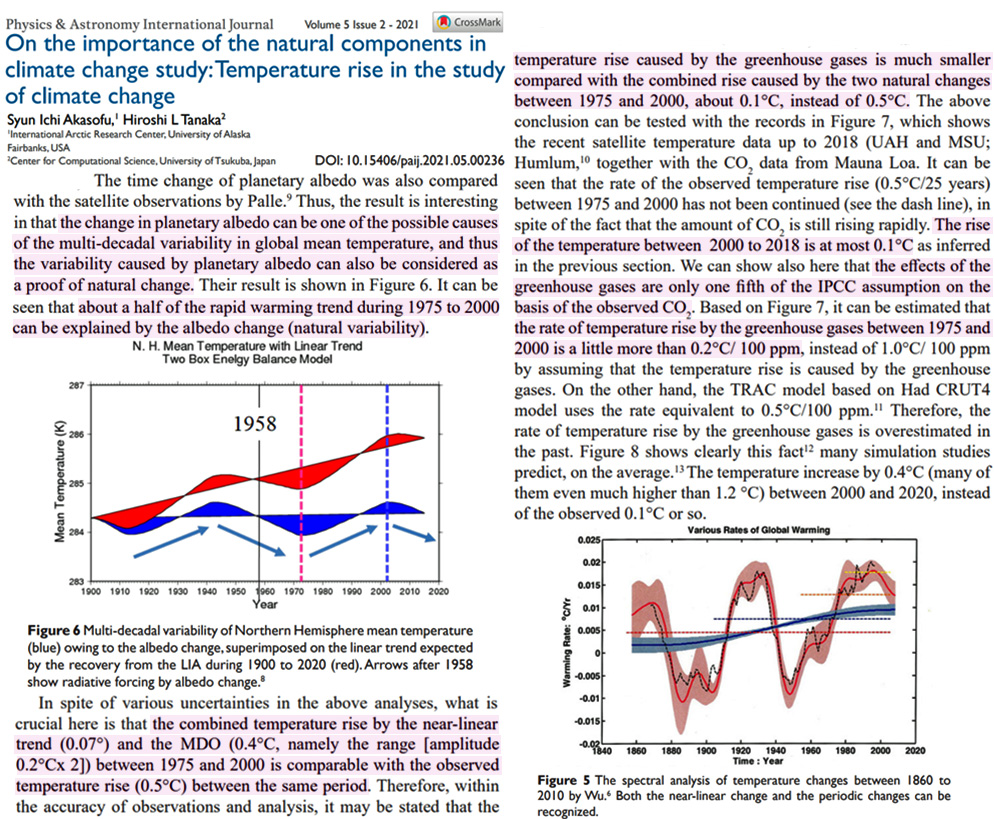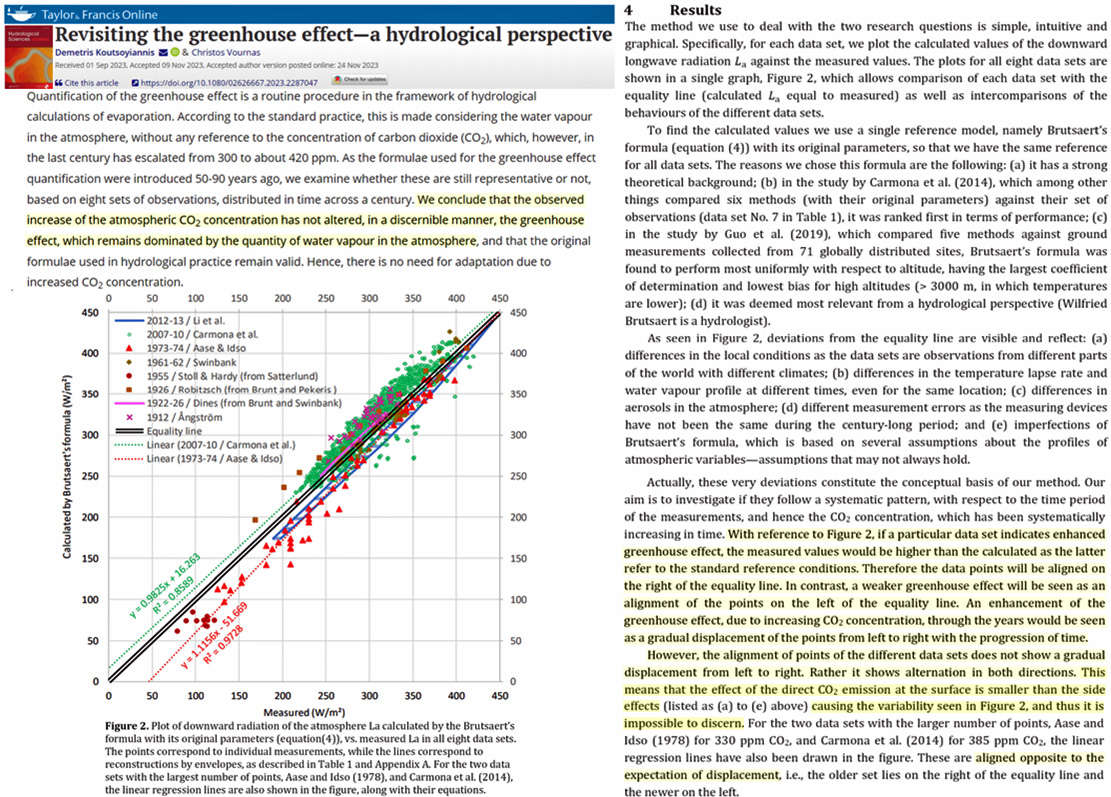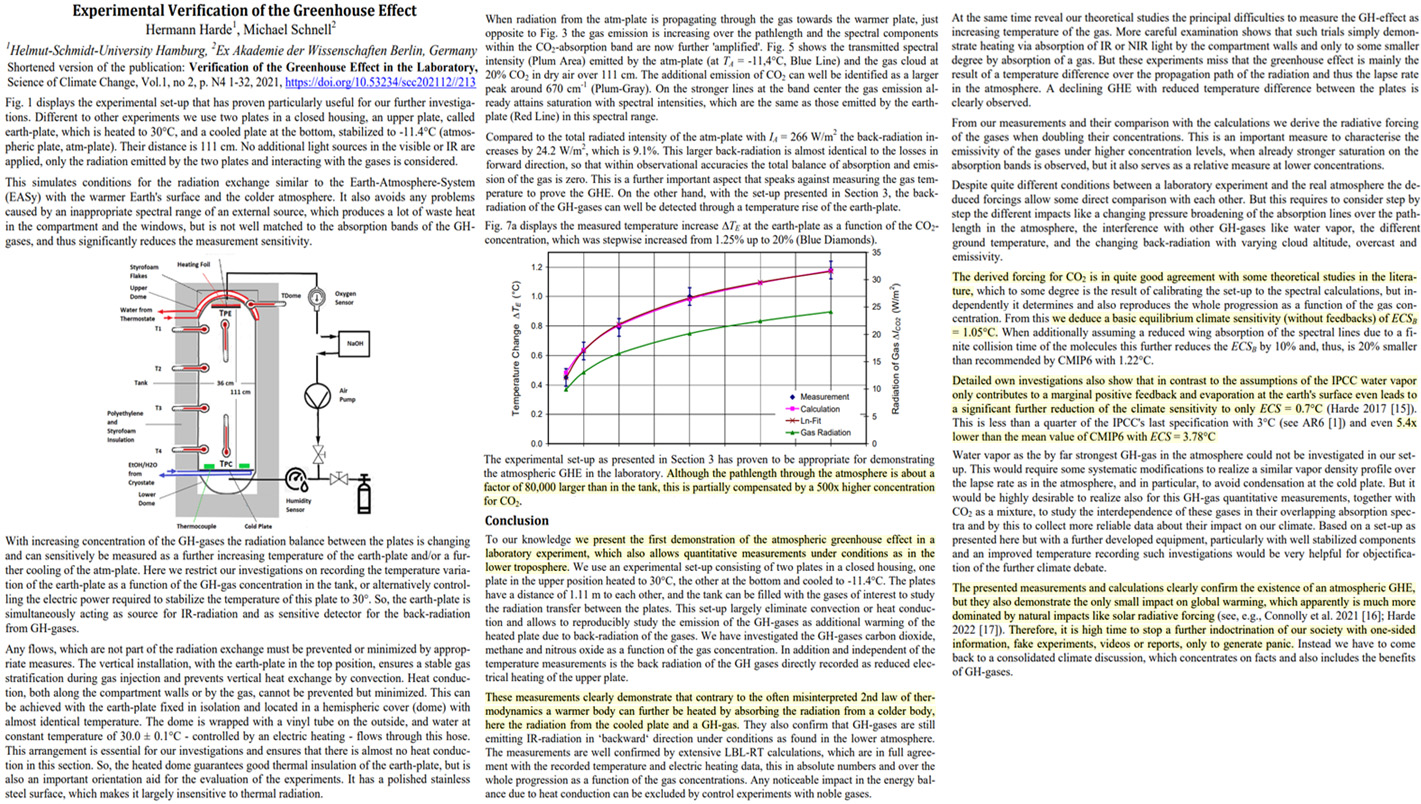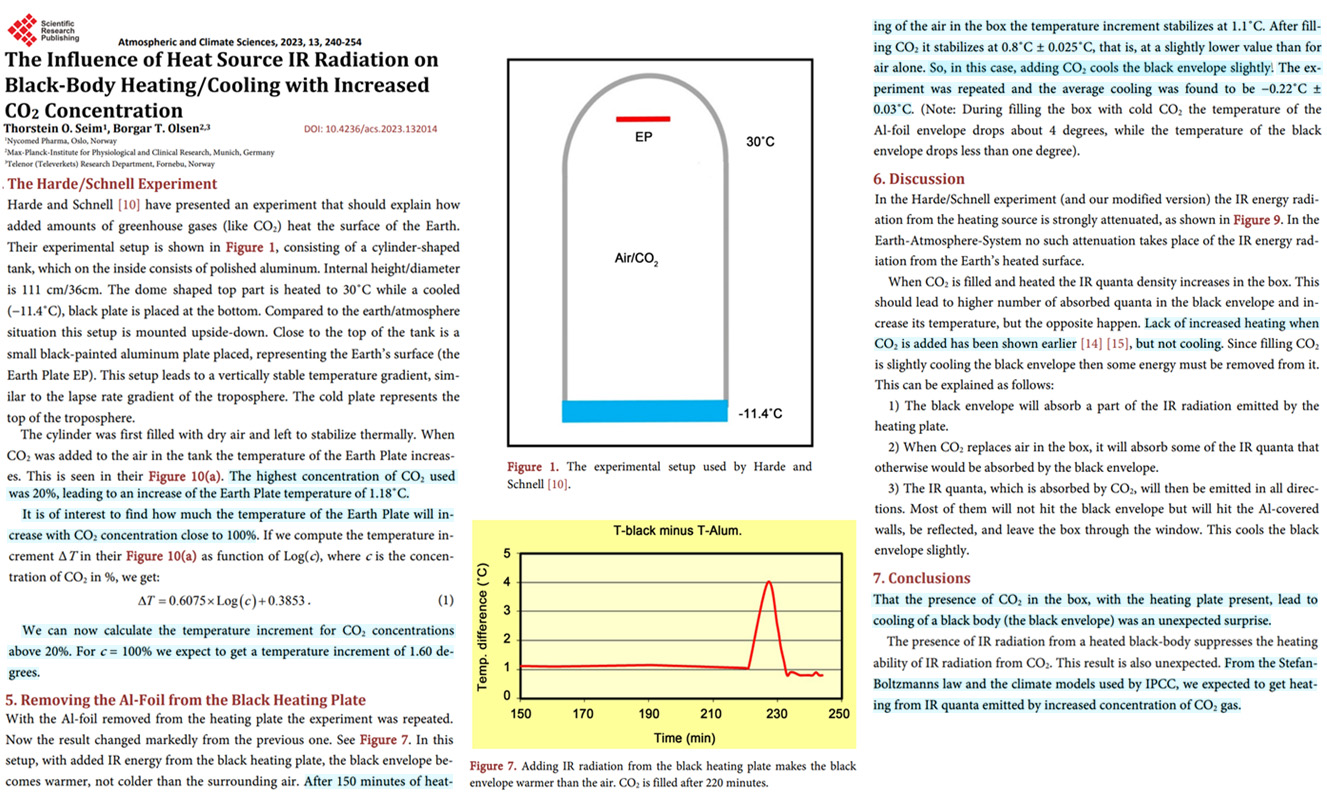We have updated our “Extremely Low CO2 Climate Sensitivity” scientific paper list with new papers added from 2022 and 2023 and some newly discovered papers from the past.
As of 2016 this list had only 50 papers on it (as indicated by the web address). In less than 8 years the list has grown to 159 (as of today).
Click on the link for the full list.
160 Papers Find Extremely Low CO2 Climate Sensitivity
A few of the sample 2022 and 2023 papers are shown here.
Akasofu and Tanaka, 2022 (100 ppm CO2 = 0.2°C global temperature change)
In spite of various uncertainties in the above analyses, what is crucial here is that the combined temperature rise by the near-linear trend (0.07°) and the MDO (0.4°C, namely the range [amplitude 0.2°Cx 2]) between 1975 and 2000 is comparable with the observed temperature rise (0.5°C) between the same period. Therefore, within the accuracy of observations and analysis, it may be stated that the temperature rise caused by the greenhouse gases is much smaller compared with the combined rise caused by the two natural changes between 1975 and 2000, about 0.1°C, instead of 0.5°C. The above conclusion can be tested with the records in Figure 7, which shows the recent satellite temperature data up to 2018 (UAH and MSU; Humlum,10 together with the CO2 data from Mauna Loa. It can be seen that the rate of the observed temperature rise (0.5°C/25 years) between 1975 and 2000 has not been continued (see the dash line), in spite of the fact that the amount of CO2 is still rising rapidly. The rise of the temperature between 2000 to 2018 is at most 0.1°C as inferred in the previous section. We can show also here that the effects of the greenhouse gases are only one fifth of the IPCC assumption on the basis of the observed CO2. Based on Figure 7, it can be estimated that the rate of temperature rise by the greenhouse gases between 1975 and 2000 is a little more than 0.2°C/ 100 ppm, instead of 1.0°C/ 100 ppm by assuming that the temperature rise is caused by the greenhouse gases. On the other hand, the TRAC model based on Had CRUT4 model uses the rate equivalent to 0.5°C/100 ppm. Therefore, the rate of temperature rise by the greenhouse gases is overestimated in the past. Figure 8 shows clearly this fact many simulation studies predict, on the average. The temperature increase by 0.4°C (many of them even much higher than 1.2 °C) between 2000 and 2020, instead of the observed 0.1°C or so.

Koutsoyiannis and Vournas, 2023
An enhancement of the greenhouse effect, due to increasing CO2 concentration, through the years would be seen as a gradual displacement of the points from left to right with the progression of time. However, the alignment of the points of the different data sets does not show a gradual displacement from left to right. This means that the effect of the direct CO2 emission at the surface is smaller than the side effects…causing the variability in Figure 2, and thus it is impossible to discern. … Quantification of the greenhouse effect is a routine procedure in the framework of hydrological calculations of evaporation. According to the standard practice, this is made considering the water vapour in the atmosphere, without any reference to the concentration of carbon dioxide (CO2), which, however, in the last century has escalated from 300 to about 420 ppm. As the formulae used for the greenhouse effect quantification were introduced 50-90 years ago, we examine whether these are still representative or not, based on eight sets of observations, distributed in time across a century. We conclude that the observed increase of the atmospheric CO2 concentration has not altered, in a discernible manner, the greenhouse effect, which remains dominated by the quantity of water vapour in the atmosphere, and that the original formulae used in hydrological practice remain valid. Hence, there is no need for adaptation due to increased CO2 concentration.

Harde and Schnell, 2022 (2XCO2 = 0.7°C)
The derived forcing for CO2 is in quite good agreement with some theoretical studies in the literature, which to some degree is the result of calibrating the set-up to the spectral calculations, but independently it determines and also reproduces the whole progression as a function of the gas concentration. From this we deduce a basic equilibrium climate sensitivity (without feedbacks) of ECSB = 1.05°C. When additionally assuming a reduced wing absorption of the spectral lines due to a finite collision time of the molecules this further reduces the ECSB by 10% and, thus, is 20% smaller than recommended by CMIP6 with 1.22°C. … Detailed own investigations also show that in contrast to the assumptions of the IPCC water vapor only contributes to a marginal positive feedback and evaporation at the earth’s surface even leads to a significant further reduction of the climate sensitivity to only ECS = 0.7°C (Harde 2017 [15]). This is less than a quarter of the IPCC’s last specification with 3°C (see AR6 [1]) and even 5.4x lower than the mean value of CMIP6 with ECS = 3.78°C. The presented measurements and calculations clearly confirm the existence of an atmospheric GHE, but they also demonstrate the only small impact on global warming, which apparently is much more dominated by natural impacts like solar radiative forcing (see, e.g., Connolly et al. 2021 [16]; Harde 2022 [17]).

Siem and Olsen, 2023 (CO2 rising from 400 ppm to 1,000,000 ppm = -0.22°C cooling)
This study deals with interactions between thermal and radiative energy flow in experimental situations of varying complexity. Of special interest is how IR energy, re-emitted from CO2 gas, behaves in an earth/atmosphere simulated setup. Such an experiment was performed by Hermann Harde and Michael Schnell where they show that IR radiation emitted from CO2 can warm a small black-body metal plate. In a control experiment, we verified this result. However, in their experiment, the amount of IR radiation from the heating element was strongly attenuated. In a modified experiment, where IR emission from the heating source is present, no heating but a slight cooling [the average cooling was found to be -0.22°C±0.03°C] of a black object is found when air [0.04%] is replaced by CO2 [100%]. The modified experimental situation is also more like the earth/atmosphere situation.






The likely number people are searching for is 1.131988243…
See: Viswanath’s constant, Random Fibonacci sequences
[…] Nearly 160 Scientific Papers Detail The Minuscule Effect CO2 Has On Earth’s Temperature […]
So, Hard & Schnell keeps the water temperature constant at 30C throughout the whole experiment. This is not the way to do it. The power of the heater that heats the water should be kept constant, but if the water is kept at 30C the power of the heat source will vary it´s input. Solar irradiation is constant. My guess is that the temperature of the plate would drop more if the heating of the plate is kept at constant power.
[…] 160 Scientific Papers Detail The Minuscule Effect CO2 Has On Earth’s Temperature (link) […]
[…] Link: https://notrickszone.com/2024/01/18/nearly-160-scientific-papers-detail-the-minuscule-effect-CO₂-h… […]